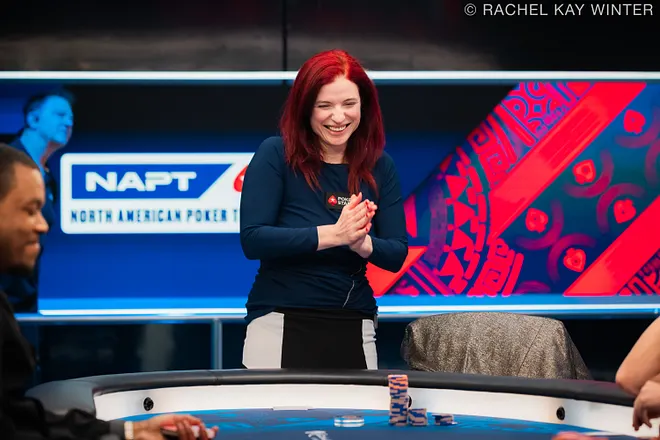What Are My Odds to Win the WSOP Main Event?
That’s the big question with no simple answer. It all depends on a few different factors.
One is your skill level of course. There will always be an element of luck needed to win any poker tournament. Especially one as large as the World Series of Poker Main Event. If it was just a luck-based tournament, then your WSOP odds would be divided evenly among all the players.
If there were 6,000 entrants, then your odds would be about 1 in 6,000. But we know that’s not the case. The WSOP attracts the best poker players from all across the world. Aside from that, there are hundreds of other players that know every mathematically correct decision to make in every situation.
Luckily, there are so many players that your chances of being seated next to one immediately are small, but still significant. Your odds of making it to the final table depend on every table you get assigned to throughout the multi-day tournament.
WSOP Odds at Every Stage
In the early stages it’s easier to survive. The blinds are low and there are tons of amateur players. This means you can wait around and pick your spots to double up. As the days go on, the blinds make it harder to survive and short-handed action means you can’t just wait around anymore.
The probability of professional players also increases during this stage as more skillful players become the most likely to survive this stage. When you get to the final table, Vegas oddsmakers then start making official odds for the final table. These tend to range from +100 all the way to +2000. So, you can say that odds are considerably larger when there are thousands and thousands of players at the beginning of the tournament. There’s really no hard numbers or statistical studies on what the odds are for an amateur player as there are so many different factors at play. Some people have estimated it is as high as 1 in 100,000.
So, your WSOP odds are probably somewhere in between 1 in 6,000 or 100,000, depending on your skill level, table selection and good old fashioned luck.
Key Facts about the WSOP
- The biggest poker series in the world with 70+ events and millions in prizes.
- The majority of tournaments at the WSOP are open events.
- Amateur poker player Chris Moneymaker won the 2003 Main Event for $2.5 million after qualifying for just $40 on an online poker site.
- Buy-ins for events at the WSOP start at $365 and scale up to a staggering $1 million.
- The biggest-ever WSOP Main Event took place in 2012 with Jamie Gold winning $12 million.
- Some of the most successful WSOP players include Phil Hellmuth, Doyle Brunson, Phil Ivey, Johnny Chan, Erik Seidel and Daniel Negreanu.
Amateur vs Pros WSOP Odds
The World Series of Poker is really the world’s only sporting event that pits amateurs and full-time professionals against one another. As long as you can afford the $10,000 buy-in, you’re a contender for the WSOP Main Event.
For most of the WSOP Main Event’s history, this buy-in was a pretty hefty barrier that kept the number of amateurs down. But the rise of online sites with satellites that could send players to the WSOP for just $1 meant there were hundreds and even thousands of amateurs heading to the Main Event.
While each individual amateur’s odds of winning decreases with skilled players and a larger player pool, the odds of an amateur winning increases because there are just so many of them. Now pros have to survive a minefield of amateur players throughout the tournament with unpredictable playstyles.
Every now and then we get some memorable amateur vs. pro matchups. None more epic and consequential than the Sam Farha vs. Chris Moneymaker heads-up battle in 2003.

Sam Farha was an old-school Las Vegas pro with a cigar in his mouth, while Moneymaker was an accountant from Tennessee who qualified for the $10,000 buy-in event with just $86. Moneymaker rose throughout the tournament and faced a final table filled with pros. His final matchup with Farha was the perfect embodiment of the pro vs amateur and the amateurs came out on top.
After that there’s been more amateurs like Jamie Gold who’ve taken down the tournament. There have also been popular amateurs making the final table like Darvin Moon and Dennis Phillips. There have also been a number of pros though, including Phil Ivey and Daniel Negreanu who nearly made the November Nine the year Joe McKeehen won.
McKeehen himself was a pro too though, and so have most of the WSOP Main Event champions over the last decades. A large number of amateurs have made the final table, but fewer have survived to take it down.
So, it seems like pros will always be more likely to take down the event. This also means that skill –in the long-term– is much better than luck in poker.
Modern WSOP Tournament Format
There are generally 60 to 77 side events and every one of them awards a WSOP gold bracelet. Almost every format of poker is available for play including:
- No-Limit Hold’em
- Pot-Limit Omaha
- Limit Hold’em
- Seven-Card Stud
- 2-7 Triple Draw
- Omaha Hi-Lo
- Razz
- HORSE
- 8-Game
The buy-ins at the WSOP range from just $365 all the way up to $50,000 for the Poker Players Championship, which utilizes every single poker game. Periodically the WSOP also hosts a blockbuster $1-million buy-in tournament for Super High Rollers.
The highlight of the WSOP is still the $10,000 Main Event, which takes a little over two weeks to complete thanks to the massive field. It’s considered one of the “softest” big buy-in events in the world. This makes it a favorite among pros and recreational players.
Odds of Winning a WSOP Bracelet
There are going to be 88 bracelet events in 2021. Check the full 2021 WSOP schedule for more details on each event. They’ll range from low buy-in events with huge fields to huge buy-ins with small fields brimming with pros.
These odds probably have even more variables than your shot at winning the WSOP Main Event. This depends on how many events you’re willing to play, what your skills are in each event, the number of entries and plenty more.
There are some signposts out there though. Several pros calculate their odds at winning a bracelet and take action on it.
Eli Elezra made bracelet bets popular back in 2007, after a discussion about whether winning bracelets was easier back before the poker boom. Elezra gave himself 5-to-1 odds on $100,000 and then Barry Greenstein gave him 10-to-1 on $25,000.
Elezra did end up winning the $3,000 seven card stud hi-lo event for that WSOP, cashing in big on his bracelet bets.
One of the most famous bracelet bets was in 2014 when Daniel Negreanu and Phil Ivey bet the world even money that at least one of them would win a bracelet in the 63-event 2014 World Series of Poker. Phil Ivey ended up winning a $1,500 Eight Game Mix event to bring the duo their winnings.
Other bets have been shrouded in a bit more mystery. Tom Dwan laid 3-to-1 odds on him winning a bracelet in 2011 as long as some multiyear bracelet bets. No one knows exactly how much he was teed up to win. But, estimates have it going up to $20 million. All this money came from the high stakes community.
Dwan ended up getting heads-up for a bracelet early in the summer. This almost bankrupted the high roller community. Simon Watt ended up taking it down and preventing Dwan from winning a bracelet.
More recently Daniel Negreanu bet $1 million that he’d win a bracelet in 2020 laying 2.5-to-1 odds on himself to win an online event.
Negreanu played a ton of online events that year but failed to score a win. Bracelet bets aren’t a thing of the past either. In 2021, high stakes pro Landon Tice laid 10-to-1 odds on himself to win a WSOP Bracelet.

With this in mind, you can start to gauge what your odds can be. Two of the best players in the world think they’re about even to win a bracelet in any given year. Meanwhile high stakes professionals estimate they have 3 to 10-to-1 odds to win a bracelet.
This takes into account that they have the bankroll to play nearly every event. So, if you’re only playing an event or two, your chances of winning a bracelet drop considerably. Even top winning players only win about 1 percent of the tournaments they play and cash in about 15 percent.
On top of that, your skill level will also heavily affect your odds. At the very best you’ll have about 10-to-1 odds. Chances are it’s more in the 1,000-to-1 or lower if you’re an amateur playing an event or two.
If you’re still planning things out, why not check out the full WSOP schedule to see which events are best suited to you and give you the best chances of winning a bracelet.



Comments